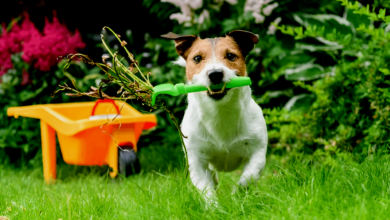
How to Help Your Pet Maintain a Healthy Weight
Pet weight management is key to their health. Learn tips on diet, exercise, and monitoring to keep your pet fit and happy.
Helping your pet maintain a healthy weight is the cornerstone of ensuring their vitality, longevity, and overall quality of life. Just like humans, pets face significant health risks when carrying excess weight, including diabetes, arthritis, cardiovascular disease, and a diminished lifespan. Obesity in has become a global epidemic, with studies estimating that over 50% of dogs and cats in developed nations are overweight—a statistic that underscores the urgency of proactive weight management. Beyond physical health, a healthy weight enhances your pet’s energy, mobility, and emotional well-being, deepening the bond you share. This comprehensive guide will delve into actionable strategies for achieving and sustaining your ideal weight, covering nutrition, exercise, behavioral considerations, and veterinary collaboration. By embracing these principles, you empower your pet to thrive and enjoy a life filled with play, exploration, and companionship.
The Importance of a Healthy Weight for Pets
A healthy weight is not merely a number on a scale—it is a reflection of your overall health. Excess weight strains vital organs, stresses joints, and exacerbates chronic conditions, while a balanced weight supports agility, immune function, and mental sharpness. For instance, overweight cats are prone to urinary tract diseases and hepatic lipidosis, while obese dogs often develop respiratory issues and ligament injuries. Recognizing that each pet’s ideal weight varies by breed, age, and metabolism is critical. A Dachshund’s sleek frame differs vastly from a Maine Coon’s muscular build, making personalized care essential. Regular consultations with your veterinarian help establish a weight baseline and identify subtle changes before they escalate.
Nutrition: The Foundation of Weight Management
Diet is the most influential factor in your pet’s weight. Commercial pet foods vary widely in quality, calorie density, and nutritional balance, so selecting the right formula requires scrutiny. Opt for brands that prioritize whole proteins (e.g., chicken, salmon) as primary ingredients and avoid fillers like corn, soy, or artificial additives. Portion control is equally vital; feeding guidelines on packaging are general, and your pet’s needs may differ based on activity level and health status. Use a measuring cup to avoid overfeeding, and resist the urge to “eyeball” portions.
Treats, while a beloved bonding tool, can derail weight goals. Limit treats to 10% of daily calories and choose nutrient-dense options like freeze-dried meats or dental chews. For cats, consider interactive treat puzzles to slow consumption. Avoid table scraps, as human foods—especially fatty or seasoned items—can disrupt digestion and lead to weight gain. If your begs, redirect their attention with play or affection instead of food.
Special diets may be necessary for with medical conditions. Prescription weight-loss foods, high in fiber and protein, promote satiety while cutting calories. Hydration also plays a role; wet food for cats, for example, can aid weight loss by providing moisture and reducing hunger cues. Always transition diets gradually to avoid gastrointestinal upset.
Building an Active Lifestyle
Physical activity is indispensable for burning calories and maintaining muscle mass. Dogs thrive on structured routines: aim for 30–60 minutes of daily exercise, such as brisk walks, fetch, or agility training. Breeds like Border Collies or Labradors may need more vigorous activities, while seniors or brachycephalic breeds (e.g., Bulldogs) require gentler sessions. Incorporate mental stimulation too—scent games or obedience training engage their minds and bodies.
Cats, natural hunters, need opportunities to stalk and pounce. Laser pointers, feather wands, or battery-operated mice mimic prey and trigger instinctual behaviors. Vertical spaces like cat trees or window perches encourage climbing, while puzzle feeders make mealtime a workout. Even 15 minutes of play daily can prevent weight gain and curb destructive habits born of boredom.
For multi- households, tailor activities to individual needs. A spry kitten and a sedentary older dog might require separate playtimes. Consistency is key: irregular exercise can lead to frustration or weight fluctuations.
Monitoring and Adjusting Your Approach
Regular weigh-ins—monthly at home or during vet visits—help track progress. Sudden weight changes may signal underlying issues like thyroid disorders or fluid retention. Keep a journal noting diet adjustments, exercise routines, and behavioral shifts to identify patterns.
Body condition scoring (BCS) is a hands-on tool to assess fat distribution. For dogs, you should feel their ribs with slight pressure and see a tapered waist. For cats, a small fat pad over the ribs is normal, but a sagging belly or “apron” indicates excess weight. Share BCS results with your vet to refine your strategy.
Adjustments may be necessary as your pet ages or seasons change. Winter months might reduce outdoor activity, requiring calorie cuts, while summer hikes could demand increased portions. Stay flexible and responsive.
Preventive Care and Veterinary Collaboration
Your veterinarian is an indispensable partner in weight management. Annual check-ups include metabolic screenings, dental exams, and dietary advice. Bloodwork can detect conditions like hypothyroidism or diabetes early, allowing timely intervention.
For overweight pets, vets may design a phased weight-loss plan, ensuring no more than 1–2% body weight is lost weekly to avoid muscle wasting. They can also recommend therapeutic exercises for pets with arthritis or mobility issues.
Spaying/neutering affects metabolism, often slowing it. Discuss post-surgery dietary adjustments with your vet to prevent weight gain.
Addressing Emotional and Behavioral Factors
Pets, like humans, may eat out of stress or boredom. Anxiety-driven overeating, common in rescue animals, can be mitigated with environmental enrichment: toys, scratching posts, or companionship. Avoid using food as a sole comfort tool; instead, create a calming environment with cozy beds or pheromone diffusers.
Multi-pet dynamics matter. Dominant pets may hoard food, requiring separate feeding areas. Slow-feed bowls prevent gulping, reducing bloat risk in dogs.
The Role of Pet Owners:
Your habits shape your pet’s lifestyle. An active owner who hikes or jogs naturally encourages a dog’s fitness. Conversely, sedentary habits may normalize inactivity. Involve the whole family in feeding and exercise routines to ensure consistency.
Educate children on proper treat portions and the dangers of overfeeding. Frame weight management as an act of love, not deprivation.
Read More: Natural Remedies for Common Pet Ailments in the UK
Conclusion
Helping your pet maintain a healthy weight is a lifelong commitment rooted in knowledge, vigilance, and compassion. By prioritizing nutrient-rich diets, fostering active lifestyles, and collaborating with your veterinarian, you safeguard your against preventable diseases and enrich their daily experiences. Small, consistent changes—like swapping a treat for a play session or introducing a new exercise routine—yield profound long-term benefits. Remember, your dedication reflects the deep bond you share, transforming care into a joyful partnership.
As you embark on this journey, celebrate milestones, whether it’s a smoother gait in your arthritic dog or a cat’s renewed zest for play. Challenges will arise, but patience and adaptability will guide you. Ultimately, a healthy weight is not an endpoint but a dynamic, evolving goal that ensures your pet’s years are filled with vitality and love. Start today—your pet’s vibrant future awaits.
FAQs
How can I tell if my pet is overweight?
Check for a lack of a visible waist, difficulty feeling ribs under fat layers, or lethargy. Your vet can perform a body condition score to assess weight status accurately.
What human foods are safe for occasional treats?
Small portions of plain cooked chicken, pumpkin, or blueberries are safe. Avoid grapes, onions, chocolate, and high-sodium foods, which are toxic.
How do I exercise a pet with mobility issues?
Low-impact activities like swimming or short, gentle walks help. Consult your vet for tailored exercises or physical therapy options.
Can weight gain be a sign of illness?
Yes. Sudden weight changes may indicate hormonal imbalances, organ dysfunction, or fluid retention. Always consult a vet for unexplained shifts.
How do I manage weight in multi-pet households?
Feed pets separately to control portions, use microchip-activated feeders, and tailor exercise routines to individual needs to prevent competition or overeating.








One Comment